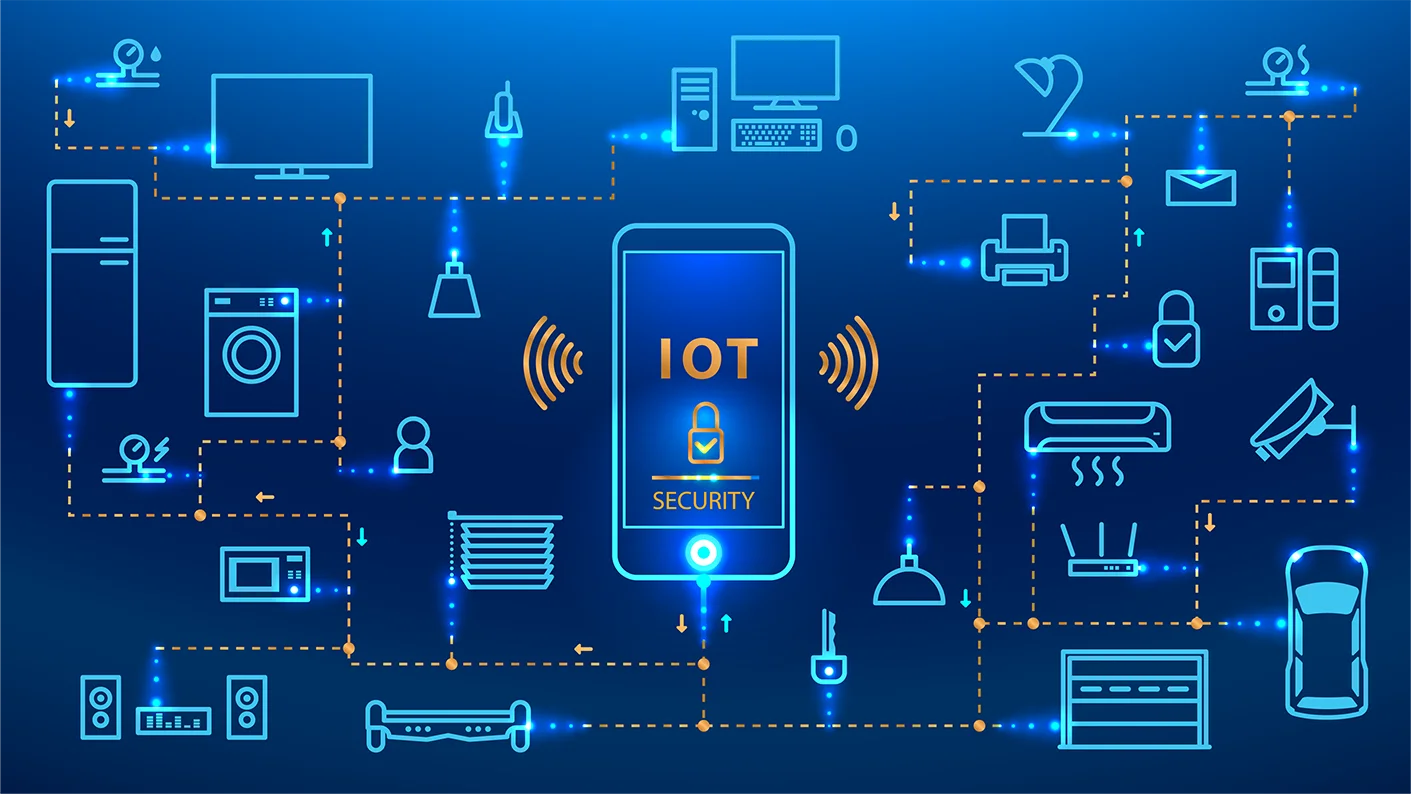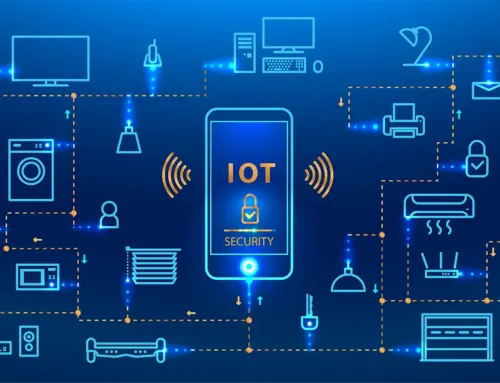
Cybersecurity in IoT: Securing Smart Devices
Securing Your IoT Device: Internet of Things in Smart Cybersecurity Tips
In an increasingly interconnected world, the Internet of Things (IoT) has revolutionized how we interact with technology. From smart home devices to industrial sensors, IoT devices are now integral to our daily lives. However, this proliferation of connected devices has also introduced significant cybersecurity challenges. This article provides essential tips and guidance to help you secure your IoT devices and protect your digital life.
Understanding IoT Smart Security
What is an IoT Device?
An IoT device, or Internet of Things device, is any physical device connected to the internet that can collect, transmit, and exchange data. These many IoT devices range from simple sensors to complex systems, including security cameras, smart thermostats, and even industrial machinery. The key characteristic of an IoT device is its ability to communicate and interact with other devices and systems over a network. Understanding the nature of an IoT device is the first step in securing your IoT ecosystem, mitigating potential security vulnerabilities, and ensuring that your connected environment remains safe and reliable.
Importance of IoT Security
IoT security is of paramount importance because a security breach in even one connected device can compromise an entire network. The potential security impact of unsecured IoT devices extends far beyond individual inconvenience, posing significant cybersecurity risks to personal data, financial information, and even critical infrastructure. Securing your IoT devices is not just about protecting your personal smart home; it’s about ensuring the safety and integrity of the broader IoT ecosystem and preventing cyberattacks. Ignoring IoT security issues can lead to severe consequences, making proactive security measures essential for securing the IoT.
Common Security Risks in IoT
Common security risks in IoT include weak passwords, unencrypted data transmission, and outdated firmware. Cyber criminals often exploit these security vulnerabilities to gain unauthorized access to IoT devices, using them as entry points to infiltrate networks and launch IoT attacks. Many IoT devices lack adequate security protocols, making them easy targets for cyberattacks. Furthermore, the sheer number of connected devices in an IoT network increases the attack surface, creating numerous potential security issues. Addressing these cybersecurity risks requires a comprehensive approach that includes robust security measures and ongoing vigilance.
IoT Security Challenges
Identifying Security Vulnerabilities
One of the primary IoT security challenges lies in identifying security vulnerabilities within the many IoT devices that comprise the IoT network. An expert network security assessment is crucial for performing a thorough analysis and identifying potential security vulnerabilities. These assessments can reveal weaknesses in security protocols, outdated firmware, and other potential entry points for cyber criminals, highlighting the importance of meeting security requirements. Regularly scanning your smart device and IoT systems for security issues is an important step in protecting your IoT devices and preventing cyberattacks. By proactively addressing security vulnerabilities, organizations can significantly enhance their overall IoT security posture and protect the integrity of their IoT technology.
Impact of Security Breaches
The impact of security breaches in IoT can be far-reaching and devastating. A single security breach in a connected device can compromise an entire IoT network, leading to data theft, financial losses, and reputational damage. Cyber threats can exploit security vulnerabilities to gain unauthorized access to sensitive information or disrupt critical IoT applications. In a smart home, a security camera could be hacked, leading to privacy violations. In industrial settings, a compromised IoT device could cause significant operational disruptions. Therefore, implementing robust security measures and advanced security solutions is essential to mitigate the potential impact of security breaches in your IoT ecosystem. Secure IoT is crucial for maintaining trust and ensuring business continuity within a comprehensive security strategy.
Challenges in Securing IoT Devices
Securing your IoT presents unique cyber security challenges due to the sheer number and diversity of connected devices. Many IoT devices lack adequate security protocols, making them easy targets for cyberattacks. Furthermore, the limited processing power and memory of some IoT devices can make it difficult to implement robust security measures. The lack of standardization across the IoT ecosystem also adds complexity to IoT device security. Overcoming these cybersecurity challenges requires a multifaceted approach that includes implementing strong security protocols, regularly updating firmware, and educating users about security best practices. Proactive steps in securing your IoT are critical to maintaining a secure IoT environment. The security risks from unsecured IoT can be easily turned into cyber threats, emphasizing the need for safe IoT practices.
Security Measures for IoT Devices
Implementing Best Practices
Implementing security best practices is crucial for securing your IoT and mitigating potential security risks. Managed IT Services provide assurance of a secure and safe infrastructure, encompassing both IT network security and IT network management. Teamwin Global Technologica emphasizes proactive threat management, continuously monitoring for cyber threats and implementing rapid responses to prevent and mitigate cyberattacks. Furthermore, cloud security and regulatory assurance are vital components of a robust security posture, ensuring that cloud-based operations adhere to all relevant regulatory requirements. By adopting these comprehensive security measures, organizations can significantly reduce the security vulnerabilities associated with many IoT devices and fortify their defenses against evolving cyber threats.
Choosing Secure IoT Solutions
Choosing secure IoT solutions is paramount in establishing a robust IoT cybersecurity posture. Teamwin Global Technologica offers a comprehensive suite of IT security solutions, including advanced firewalls such as FortiGate, Sophos, and Checkpoint. Robust endpoint security, exemplified by SentinelOne and Crowdstrike, provides another layer of security to protect IoT technology and smart devices. Privileged Access Management (PAM) enhances security protocols by controlling and monitoring access to sensitive resources. Additionally, enterprise CCTV and biometric systems further contribute to a layered security approach. Selecting IoT solutions from trusted vendors with a proven track record in security is crucial for securing your IoT and mitigating potential security issues and cyber threats.
Regular Updates and Maintenance
Regular updates and maintenance are critical for maintaining the security of your IoT. Many IoT devices are vulnerable due to outdated firmware and software, which can significantly reduce security. Keeping your IoT systems up-to-date ensures that you have the latest security patches and are protected against known security breaches. This includes regularly updating the firmware on all connected devices, including smart home devices, security cameras, and industrial sensors. Regular network security audits can help identify potential security vulnerabilities and ensure that all security protocols are functioning correctly. By prioritizing regular updates and maintenance, you can secure your IoT and significantly reduce the risk of cyberattacks.
Examples of IoT Security Breaches
Case Studies of Notable Incidents
Examining case studies of notable incidents involving IoT device security breaches provides invaluable insights into the potential risks and consequences associated with unsecured IoT deployments. These security breaches often involve cyber criminals exploiting security vulnerabilities in IoT devices to gain unauthorized access to networks and data. For example, compromised security cameras have been used to launch large-scale cyberattacks, highlighting the importance of securing your IoT devices. By analyzing these incidents, organizations can identify common patterns and security issues and implement more effective security measures to protect their IoT ecosystem. Such analysis will help secure IoT and bolster network security.
Lessons Learned from Past Breaches
The security breaches of the past serve as crucial lessons in IoT security. One significant takeaway is the importance of strong security protocols and regular security updates to meet the security requirements of IoT applications. Many security incidents occur due to weak passwords, unencrypted data transmission, and outdated firmware, which compromise the level of security. Cyber threats continue to evolve, so IoT device manufacturers and users must proactively address security vulnerabilities and implement robust cyber security best practices. Learning from past mistakes can help organizations enhance their security posture, mitigate security risks, and protect their IoT devices from future cyberattacks. These advanced security solutions are essential for securing your IoT.
Strategies to Prevent Future Breaches
Preventing future security breaches in IoT requires a multi-faceted approach that encompasses both technological and organizational security measures to ensure safe IoT. Organizations must prioritize identifying and addressing security vulnerabilities in their IoT ecosystem, implementing strong security protocols, and ensuring regular security updates. Employee training and awareness programs are also essential for educating users about security best practices and potential security risks. Furthermore, collaborating with cybersecurity experts and participating in industry-wide security initiatives can help organizations stay ahead of emerging cyber threats and fortify their defenses against potential security breaches. Protecting your IoT devices starts with proactive planning.
Future of IoT Cybersecurity
Emerging Trends in IoT Security
The landscape of IoT security is constantly evolving, driven by advancements in technology and the increasing sophistication of cyber attacks. Emerging trends in IoT security include the adoption of artificial intelligence (AI) and machine learning (ML) to detect and respond to security threats in real-time, enhancing the level of security. Blockchain technology is also being explored as a means to enhance the security and integrity of IoT data. Additionally, the rise of edge computing is driving the need for distributed security solutions that can protect IoT devices at the edge of the network. These advanced security measures are crucial for securing your IoT and mitigating potential security risks.
Predictions for IoT Cyber Threats
As the Internet of Things continues to expand, the number and sophistication of IoT cyber threats are expected to increase. Predictions for future security threats include the rise of AI-powered cyber attacks that can automatically identify and exploit security vulnerabilities in IoT devices. Ransomware attacks targeting critical infrastructure and industrial IoT systems are also a growing concern. Furthermore, the increasing interconnectedness of IoT devices and systems will create larger attack surfaces, making it more challenging to secure your IoT and protect against IoT attacks. Staying ahead of these evolving security threats requires proactive threat intelligence and robust security solutions.
Preparing for the Next Generation of IoT Security
Preparing for the next generation of IoT security requires a proactive and strategic approach. Organizations must invest in advanced security technologies, such as AI-powered threat detection and blockchain-based security solutions. They also need to foster a culture of security awareness and empower employees to identify and report potential security issues. Collaboration and information sharing among IoT device manufacturers, security vendors, and industry stakeholders are essential for developing effective security best practices and standards. Securing your IoT for the future requires a comprehensive and collaborative effort to address the evolving landscape of cybersecurity risks and cyber threats. These many IoT devices need constant network security.
5 Surprising Facts About Cybersecurity in IoT Securing Smart Devices
- Over 70% of IoT devices are vulnerable to attacks due to weak security measures.
- Approximately 30% of all data breaches involve IoT devices, highlighting their potential as entry points for cybercriminals.
- Many IoT devices lack basic security features, such as encryption and secure authentication, making them easy targets.
- The average lifespan of an IoT device is over five years, during which time security vulnerabilities can accumulate without updates.
- Research shows that 95% of IoT security incidents could be prevented with proper security protocols and regular updates.
What are the common security risks associated with IoT devices?
Common security risks associated with IoT devices include unauthorized access, data breaches, and vulnerabilities in device firmware. Many IoT devices are often not built with strong security protocols, making them easy targets for cyber criminals. These security risks can lead to significant threats and breaches of security within a smart environment, impacting both personal privacy and system integrity.
How can I implement security measures for IoT devices?
Implementing security measures for IoT devices involves using strong passwords, enabling two-factor authentication, and regularly updating device firmware to patch security flaws. Additionally, employing network security tools such as firewalls and intrusion detection systems can protect your IoT ecosystem from cyber attacks. It’s essential to assess the security requirements of each device to ensure comprehensive protection.
What are the best practices for securing the IoT?
Best practices for securing the IoT include regularly changing default passwords, disabling unnecessary features on devices, and segmenting IoT devices from the main network. Utilizing advanced security software to monitor traffic can also help in detecting potential security breaches. Educating users about IoT security challenges is crucial for maintaining a safe IoT environment.
What are the common security vulnerabilities in IoT systems?
Common security vulnerabilities in IoT systems include weak authentication protocols, lack of encryption, and insecure communication channels. Many IoT devices come with hard-coded credentials that are difficult to change, leading to increased exposure to cyber threats. Identifying and addressing these security weaknesses is vital for protecting connected IoT devices.
What are the implications of IoT security breaches?
IoT security breaches can result in unauthorized access to sensitive data, control over connected devices, and disruption of services. These breaches often lead to financial losses, reputational damage, and a loss of consumer trust. Understanding the implications of such security risks is essential for organizations to develop effective cybersecurity strategies.
How can one protect IoT devices from cyber attacks?
To protect IoT devices from cyber attacks, it is important to implement a multi-layered security approach that includes regular software updates, the use of strong encryption methods, and continuous monitoring for unusual activity. Employing security solutions like VPNs and secure gateways can also help in safeguarding your IoT connections from potential threats.
What role do security protocols play in IoT device security?
Security protocols play a crucial role in IoT device security by establishing standards for authentication, encryption, and data integrity. Properly implemented security protocols can help mitigate security vulnerabilities and ensure that data transmitted between devices remains confidential. Investing in robust security protocols is essential for maintaining a safe IoT ecosystem.
What are the security challenges specific to medical IoT devices?
Medical IoT devices face unique security challenges due to the sensitive nature of the data they handle and the critical functions they perform. Security vulnerabilities in these devices can lead to severe consequences, including compromised patient safety and unauthorized access to medical records. Ensuring compliance with industry-specific security requirements is vital for safeguarding medical IoT applications.
What examples of IoT devices require special attention to security?
Examples of IoT devices that require special attention to security include smart home devices, security cameras, medical IoT devices, and connected industrial machinery. These devices often contain sensitive information or play essential roles in safety and security. Implementing stringent security practices for these devices is crucial to prevent potential security breaches and protect user data.








